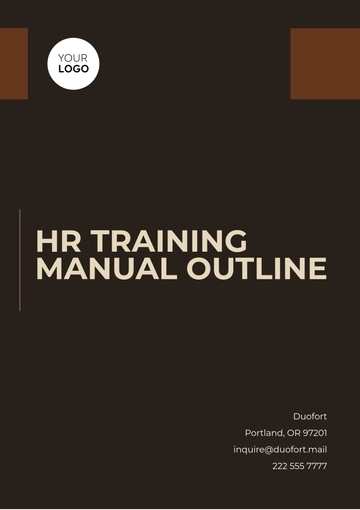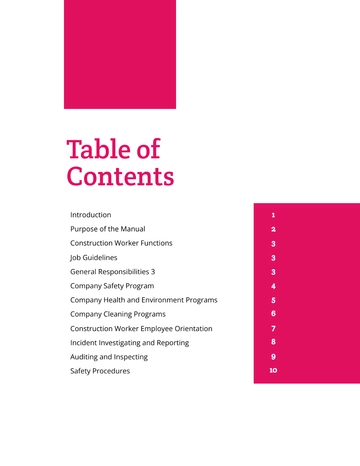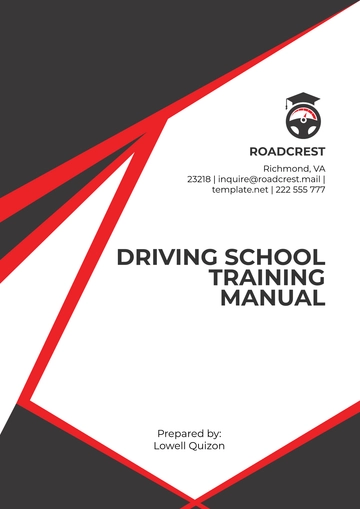Free Customer Service Training Manual

Name: | Company: | Department: | Date: |
|---|---|---|---|
[YOUR NAME] | [YOUR COMPANY NAME] | CUSTOMER SERVICE | [CURRENT DATE] |
I. Introduction
Welcome to the Customer Service Training Manual! This document is designed to equip you with the essential knowledge and skills necessary to provide outstanding customer service in our organization. As we move into 2050 and beyond, customer expectations continue to evolve. Our goal is to ensure that every customer interaction is not only positive but memorable, reinforcing our commitment to excellence and innovation in customer care.
In this manual, you will find key policies, effective communication strategies, problem-solving techniques, and real-life scenarios that will help you navigate customer interactions successfully. Together, we can build lasting relationships with our customers and uphold the values of our company.
II. Customer Service Policies
A. Customer Commitment
We are dedicated to exceeding our customers' expectations by delivering high-quality service. All employees must prioritize customer satisfaction, actively seek feedback, and act in the best interest of our customers.
B. Professional Conduct
Every employee is expected to maintain professionalism at all times. This includes:
Politeness: Use courteous language and a respectful tone.
Appearance: Adhere to the company’s dress code to present a professional image.
C. Confidentiality
We respect our customers' privacy. All customer information must be handled confidentially and shared only with authorized personnel. Violations of this policy may result in disciplinary action.
D. Timeliness
Responding to customer inquiries and issues promptly is critical. Aim to resolve issues on the first contact whenever possible. For issues that cannot be resolved immediately, provide the customer with an estimated time for follow-up.
E. Continuous Learning
In the fast-paced world of customer service, staying updated with industry trends and technological advancements is vital. Employees are encouraged to engage in ongoing training sessions and self-directed learning.
III. Communication Skills
A. Active Listening
Pay Attention: Maintain eye contact and nod to show engagement.
Reflect: Paraphrase what the customer says to demonstrate understanding. Example: “So, what you’re saying is…”
B. Clear and Concise Language
Avoid Jargon: Use simple language that is easy to understand.
Be Direct: Get to the point quickly to avoid confusion.
C. Empathy
Acknowledge Feelings: Recognize the customer’s emotions. Use phrases like, “I can see how that would be frustrating.”
Validate Concerns: Ensure the customer feels heard and understood.
D. Positive Language
Frame Messages Positively: Instead of saying, “I don’t know,” say, “Let me find that information for you.”
Encouraging Words: Use phrases like “I’d be happy to help you with that” to create a welcoming atmosphere.
E. Adaptability
Tailor Your Communication: Adjust your tone and style based on the customer’s demeanor and preferences.
Stay Calm: Maintain composure even in challenging situations, as your attitude influences the customer experience.
IV. Problem-Solving Techniques
A. Identify the Issue
Ask Open-Ended Questions: Encourage customers to share more about their concerns. Example: “Can you explain what happened?”
Clarify Details: Repeat what you’ve heard to ensure accuracy.
B. Explore Solutions
Offer Multiple Options: Provide different solutions and let the customer choose what works best for them.
Involve the Customer: Ask for their input in finding a resolution.
C. Take Action
Implement the Solution: Act swiftly to put the agreed-upon solution into place.
Document the Process: Record key details of the issue and solution for future reference.
D. Follow Up
Check-In: After resolving the issue, follow up with the customer to ensure their satisfaction. Use email or a quick phone call to ask if everything is resolved.
Gather Feedback: Ask for their input on the resolution process to identify areas for improvement.
V. Escalation Process
A. When to Escalate
Unresolved Issues: If a customer is unhappy with the proposed solution or if the problem is beyond your authority, it’s time to escalate.
High-Risk Situations: In cases involving security, legal issues, or severe complaints, escalate immediately.
B. How to Escalate
Inform Your Supervisor: Clearly explain the situation, including what steps you’ve already taken.
Provide Documentation: Share any relevant notes, emails, or customer interactions that can assist in resolving the issue.
C. Notify the Customer
Keep the Customer Informed: Let them know you are escalating the issue and provide details on what they can expect next.
Set Expectations: Inform them about the time frame for follow-up and who will be contacting them.
VI. Performance Expectations
A. Customer Satisfaction
Aim for High Satisfaction: Strive for a customer satisfaction score of 90% or above. Use surveys and feedback to gauge performance.
B. Resolution Time
First Contact Resolution: Aim to resolve at least 80% of issues on the first contact.
Follow-Up Timeliness: Ensure all follow-ups are completed within 48 hours.
C. Professionalism
Maintain a Professional Demeanor: Uphold a professional demeanor at all times and comply with the company dress code.
D. Continuous Improvement
Engage in Training: Attend regular training sessions and actively seek feedback from supervisors and peers to identify areas for improvement.
Set Personal Goals: Aim to develop personal objectives that align with company goals for better performance.
VII. FAQs and Scenarios
FAQ Example 1: How do I handle an irate customer?
Listen Actively: Give them your full attention.
Apologize: Express understanding and regret for the inconvenience.
Offer a Solution: Suggest practical steps to resolve their issue. If needed, escalate to a supervisor.
FAQ Example 2: What should I do if I don’t know the answer to a customer’s question?
Be Honest: Say, “I’m not sure, but I will find out for you.”
Follow-up: Ensure you provide the information they need as soon as possible.
Scenario Example 1: A customer is upset about a delayed order.
Empathize: “I understand how frustrating it is to wait for an order.”
Provide a Solution: Offer a new estimated delivery date and a discount for the inconvenience.
Scenario Example 2: A customer is unhappy with a product.
Listen: Ask them to explain what they dislike.
Offer Alternatives: Suggest a return, exchange, or store credit, depending on company policy.
Scenario Example 3: A customer has a billing question.
Clarify: Ask for their account details and verify the issue.
Explain: Walk them through their bill step by step, ensuring they understand the charges.
- 100% Customizable, free editor
- Access 1 Million+ Templates, photo’s & graphics
- Download or share as a template
- Click and replace photos, graphics, text, backgrounds
- Resize, crop, AI write & more
- Access advanced editor
Discover the ultimate Customer Service Training Manual Template on Template.net. Tailored for efficiency, our editable and customizable template is your blueprint for exceptional customer service. Accessible in our Ai Editor Tool, streamline your training process effortlessly. Elevate your customer service standards with our comprehensive template. Unlock excellence today on Template.net.





























